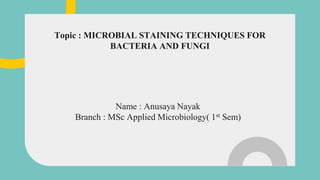
Microbial Staining Techniques for Bacteria and Fungi Identification
- 1. Name : Anusaya Nayak Branch : MSc Applied Microbiology( 1st Sem) Topic : MICROBIAL STAINING TECHNIQUES FOR BACTERIA AND FUNGI
- 2. CONTENTS 1. SIMPLE STAINING Positive staining And Negative staining 2. DIFFERENTIAL STAINING Gram stain , Zn- Stain( Acid- fast stain) , And Albert Stain 3. SPECIAL STAIN Capsular stain Flaggelar stain Endospore stain 4. FUNGAL STAIN LPCB KOH Calcofluor white stain Histopathological stain
- 3. .1 A technique used to enhance and contrast biological specimen at microscopic level. Staining is used to highlight important features of the tissue as well as to enhance the tissue contrast. Numerous staining techniques are available for visualisation,differentiation and separation of bacteria in terms of morphological characteristics and cellular structures INTRODUCTION TO STAINING 1. 2. 3. 1. 2. 3.
- 4. SIMPLE STAINING ( For examination of shape, size & arrangement of bacterial cells ) DIFFERENIAL STAINING ( For differentiating bacterial groups ) SPECIAL STAINING ( For visualising the bacterial external and internal structure ) BACTERIAL STAINING METHODS
- 5. 01 SIMPLE STAINING • A single is used to emphasize particular structure. • Basic dye such as methylene blue , crystal violet and acidic dye such are eosin,Indian ink,nigrosin are used in simple stain against a specimen.
- 6. DIFFERENTIAL STAINING • Here 2 stains are used which imparts different colours to different bacteria or bacterial structures ,which helps in differentiating bacteria. • The most commonly differential stains used are Gram stain, Acid-fast stain and Albert’s stain 02
- 7. A. Gram Stain Gram stain was devised by Christian Gram, in 1884.It is an essential procedure that is used in identification of bacteria.The stain differentiate bacteria into 2 broad groups : Gram positive and Gram negative bacteria . The Gram staining method essentially consists of 4 steps : (I)Primary staining with basic dyes, such as crystal violet (ii)Mordant is used in the form of dilute solution of Iodine (iii)Decolourization with ethanol, acetone (iv)Counterstaining with acidic dyes such as Carbol fuchsin,Safranin or neutral Red.
- 9. • It is the differential staining techniques which was first developed by Ziehl and later on modified by Neelsen. So this method is also called Ziehl-Neelsen staining techniques. • This method is used for those microorganisms which are not staining by simple or Gram staining method, particularly the member of genus Mycobacterium, are resistant and can only be visualized by acid-fast staining. • The main aim of this staining is to differentiate bacteria into acid fast group and non-acid fast groups. • Zn Stain : Carbol fuchsin (basic) • Decolourizer : Sulphuric acid, acid alcohol • Counter stain : methylene blue, malachite green B. ACID – FAST Staining ( Zn- Staining)
- 10. Fig : Microscopic view of acid fast stain Fig : Procedure of Acid- fast staining
- 11. C . ALBERT STAINING • Albert stain is a kind of differential stain used for staining and identifying metachromatic granules. • Albert stain is no different. Albert stain distinctly identifies metachromatic granules that are found in Corynebacterium diphtheriae. • It is named metachromatic because of its property of changing color i.e. when stained with blue stain they appear red in color. When grown in Loffler’s slopes, C. diphtheriae produces a large number of granules. • Albert stain is made up of two staining solutions; designated as Albert Solution 1 and Albert Solution 2, their compositions being; • Albert Solution 1: toluidine blue, malachite green, glacial acetic acid, and alcohol • Albert solution 2 : Iodine and Potassium iodide in water .
- 12. Fig : Microscopic view of Corynebacterium diptheriae
- 13. SPECIAL STAINING A . ENDOSPORE STAINING • In 1922, Dorner published a method for special staining of bacterial endospore. • The main purpose of endospore staining is to differentiate bacterial spores from other vegetative cells and to differentiate spore formers from non-spore formers. • Reagents used for Endospore Staining : • Primary Stain: Malachite green • Decolorizing agent : Tap water or Distilled Water • Counter Stain: Safranin , Stock solution (2.5% (wt/vol) alcoholic solution) 03
- 14. Fig : Microscopic view of endospore staining Fig : Procedure of spore staining
- 15. B. FLAGELLAR STAINING C. CAPSULAR STAINING This technique is used to visualize the presence and arrangement of flagella for the presumptive identification of motile bacterial species. Result: Bacterial cells appear pink which are surrounded by deeply stained flagella; the flagella may be monotrichous, amphitrichous, peritrichous, or lophotrichous. • The main purpose of capsule stain is to distinguish capsular material from the bacterial cell. A capsule is a gelatinous outer layer secreted by bacterial cell and that surrounds and adheres to the cell wall. • Reagents: 1% crystal violet and 20% copper sulfate (CuSO4.5H2O) Capsule: Clear halos zone against dark background No Capsule: No Clear halos zone
- 16. FUNGAL STAIN FUNGAL STAINING METHODS LACTOPHENOL COTTON BLUE KOH MOUNT CALCOFLUOR WHITE STAIN HISTOPATHOLOGICAL STAIN PERIODIC ACID SCHIFF (PAS) STAIN It is the recommended stain for detecting fungi. PAS positive fungi appear deep pink, whereas die nuclei stain blue . GOMORI METHENAMINE SILVER (GMS) STAIN It is used as an alternative to PAS for detecting fungi. lt stains both live and dead fungi, as compared to PAS which stains only the live fungi. GMS stains the polysaccharide component of the cell wall. Fungi appear black whereas the background tissue takes pale green color. HEMATOXYLIN AND EOSIN STAIN (H&E) STAIN H&E is the combination of two histological stains: hematoxylin and eosin. The hematoxylin stains cell nuclei a purplish blue, and eosin stains the extracellular matrix and cytoplasm pink, with other structures taking on different shades, hues, and combinations of these colors
- 17. LPCB STAINING
- 18. THANK YOU !